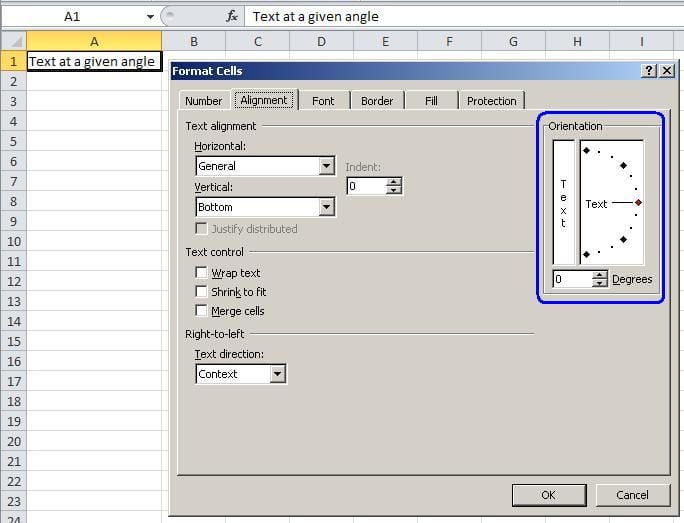

Angle text in excel file how to#
Learn how to use Excel in a quick and easy way! If you found this tutorial helpful, give us a ‘like’ and watch other video tutorials by Eas圜lick Academy. As a result, a new window will pop out where you’ll see the text file information. There, select the text file where you have your required information. Consequently, the Import Data dialog box will emerge.

If you’re curious how you could make the design of your data tables even more effective, watch more video tutorials by Eas圜lick Academy!ĭon’t miss out a great opportunity to learn: Next, select Get Data From File From Text/CSV. If you still need to set the text alignment, you can use the icons up here – align to the left, center or align to the right. Step 7: Type the water text you wish to show. Step 6: Now, we have word art style appearing in the worksheet. Step 5: Select the style you wish to have. Step 4: Now go to INSERT tab > Under Text section select Insert Word Art. Drag the orientation pointer to mark the angle you need.Īnother way is to use the box below and type in the exact number – the degree value of the angle.Ĭlick on OK and we’re done! Text orientation has been set just as we needed! How to Set the Text Alignment Step 3: Now, you will see a worksheet like this. One way is to use the points along the semicircle located in the ‘Orientation’ box. So, if we want to set the angle to let’s say 45°, there are two ways how we can do it. However, we’ll focus now on changing the text orientation, tilting it at the exact angle we need. Go to the tab ‘Alignment’ where you can find settings like text alignment. Click on the ‘Format Cell Alignment’ option.Ī pop-up window turns up. And this is what we’ll have a look at, now.
Angle text in excel file free#
You’re free to use the pre-defined options, but on occasions, you might need to rotate the text at a different, specific angle. How to Rotate the Text at a Specific Angle Some of the available options include making the text flow vertically or tilting it at a certain angle. You’ll see more options you can choose from to rotate the text. Once selected, go to ‘Home’ tab, carry on to the section ‘Alignment’ and look for the icon ‘Orientation’. Let’s say we want to do that in these three cells containing the names of the months. How to Change Text Direction Vertically in Excelįirst, select a cell or multiple cells in which you want to change text orientation. Finally hit the Ok option to finish this process. We have inserted 45 degrees for instance. Under this tab set any angles in the Degrees field. After that, press CTRL +1 to open the Format Cells dialog box. We’ll have a look at all of them using this data table as an example. First of all, select the range of cells to rotate the texts in them. ThisWorkbook.Sheets(“sheet1″).Cells(y, 4) = ws.If you’re asking how you can set text orientation in a cell, I’ll tell you as I always do, that Excel offers multiple possibilities. ThisWorkbook.Sheets(“sheet1”).Cells(y, 3) = CDate(ws.Cells(x, 3)) ThisWorkbook.Sheets(“sheet1”).Cells(y, 2) = ws.Cells(x, 2) ThisWorkbook.Sheets(“sheet1”).Cells(y, 1) = ws.Cells(x, 1) ‘col 1 ‘Put column 1,2,3 and 4 of current sheet (ws) into row y of master sheet, then increase row y to next row ‘Loop through each record (row 2 through last row) WsLR = ws.Cells(Rows.Count, 1).End(xlUp).Row If fso.GetExtensionName(wbFile.Name) = “xlsx” Then ‘Make sure looping only through files ending in. Y = ThisWorkbook.Sheets(“sheet1”).Cells(Rows.Count, 1).End(xlUp).Row + 1 Set fso = CreateObject(“Scripting.FileSystemObject”) If you’re interested in learning the ins and outs of VBA, check out my ultimate Excel programmer course, which is now over 10 hours of jam packed Excel content!
Angle text in excel file zip file#
Obviously, you can copy and paste this code or download the zip file that contains the three demo workbooks and the master workbook with all the code, but if you would prefer an over the shoulder video guide, just watch the YouTube video at the end of this post. We’re going to take this data and put it on to the master workbook, meaning the workbook where the code originates from. Without getting too technical, the purpose of this article is to show you how you can loop through multiple files and a particular folder on your computer and scrape data from each worksheet. Sometimes using loops with the fileSystemObject in Visual Basic isn’t the most intuitive thing to use, but in this article I want to show you some basic things you can do with it.


 0 kommentar(er)
0 kommentar(er)
